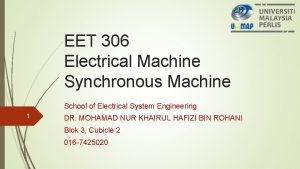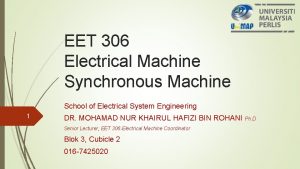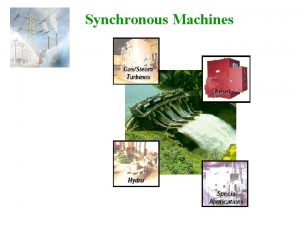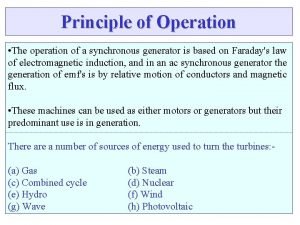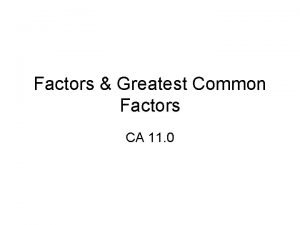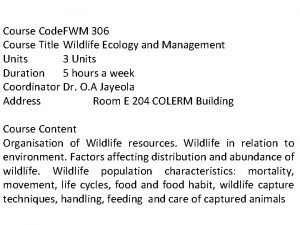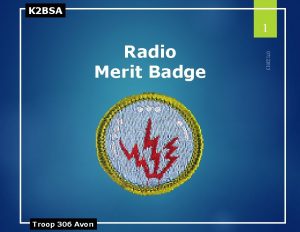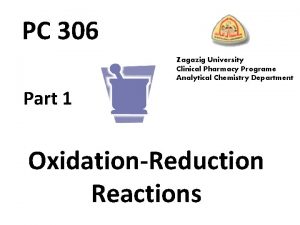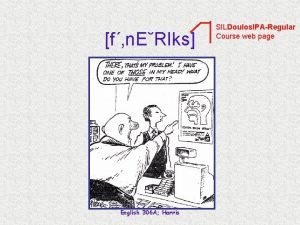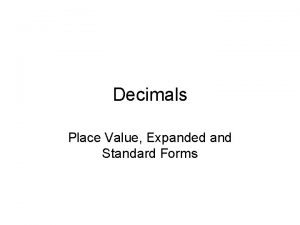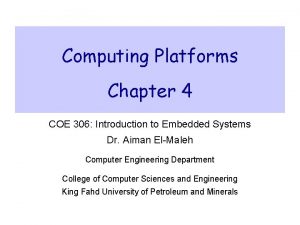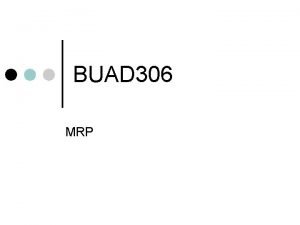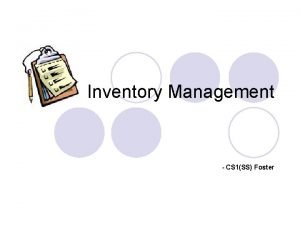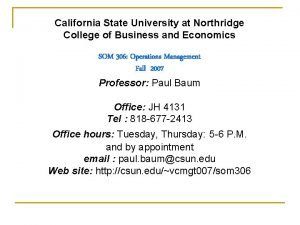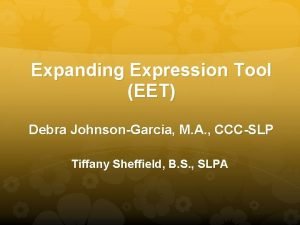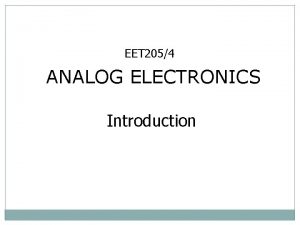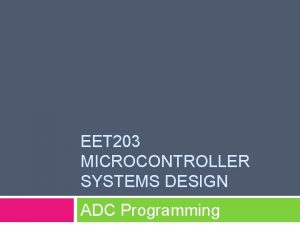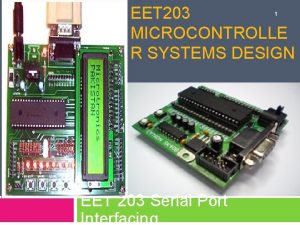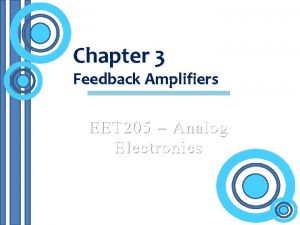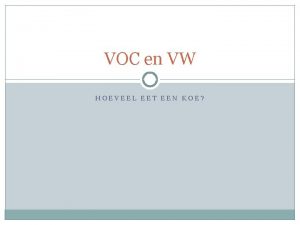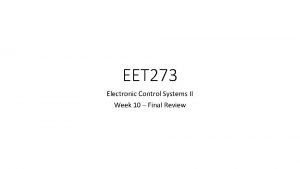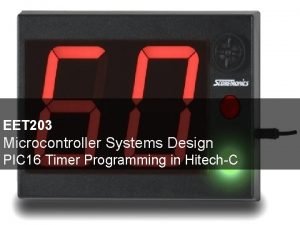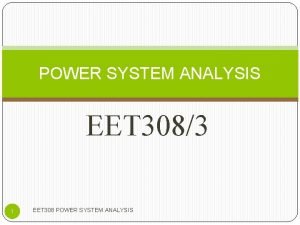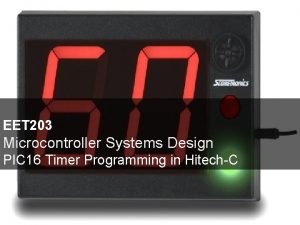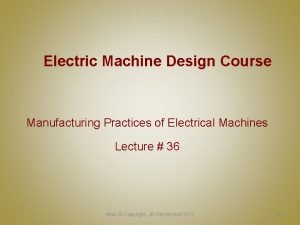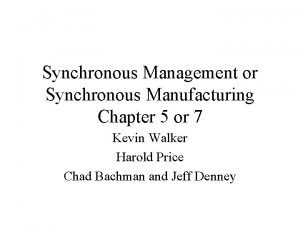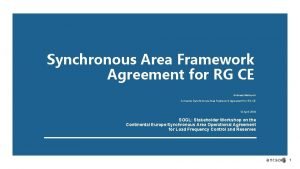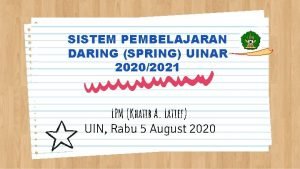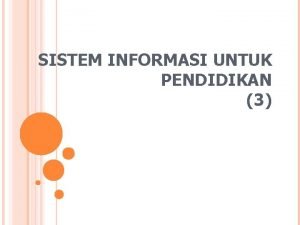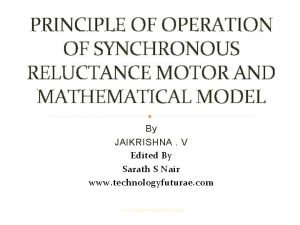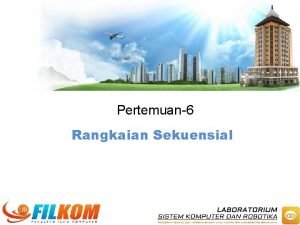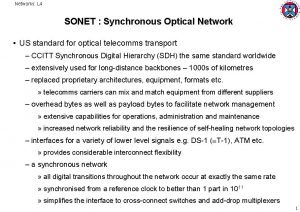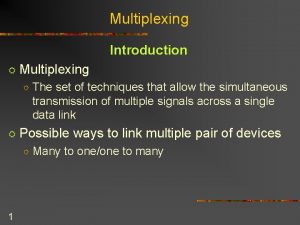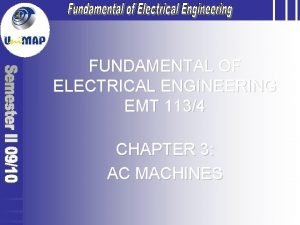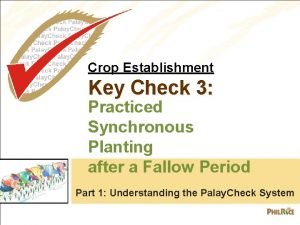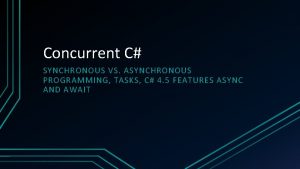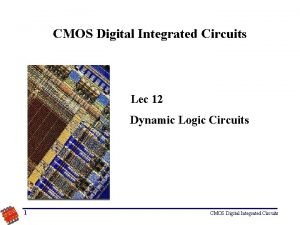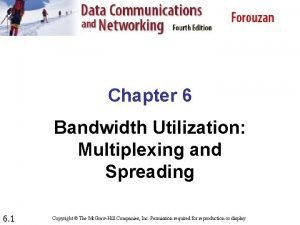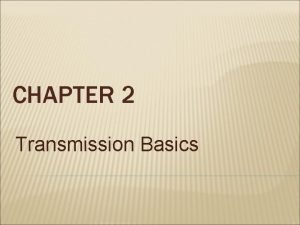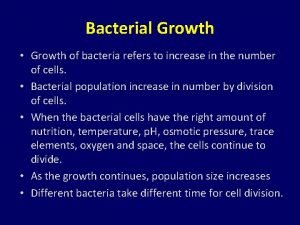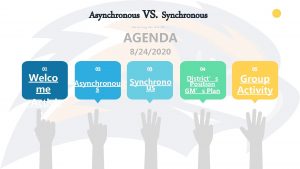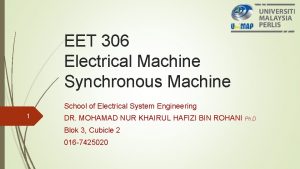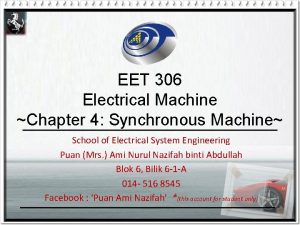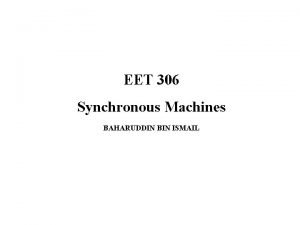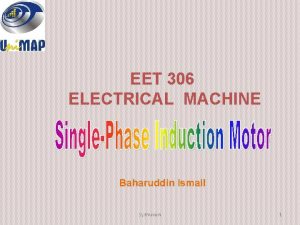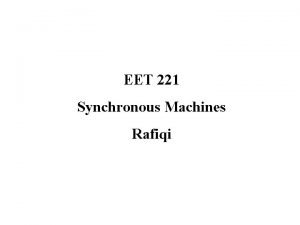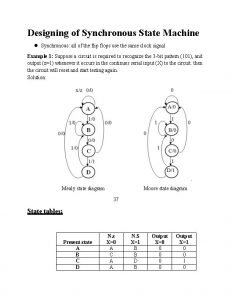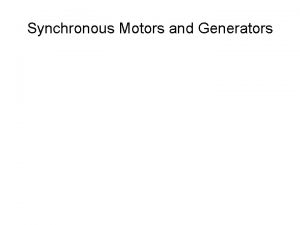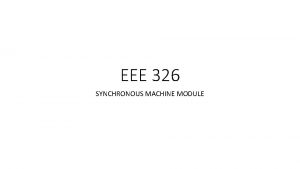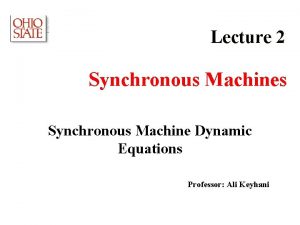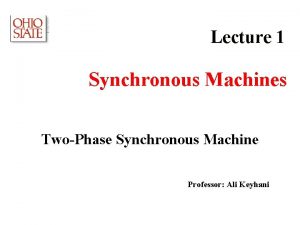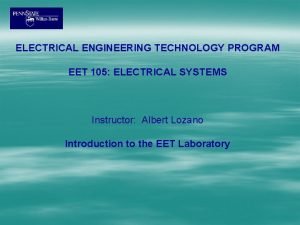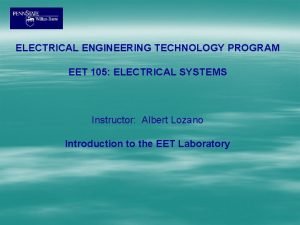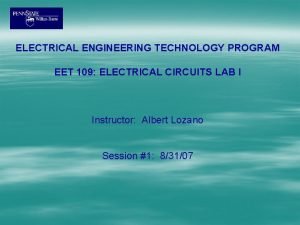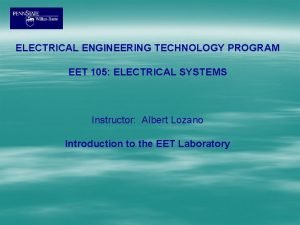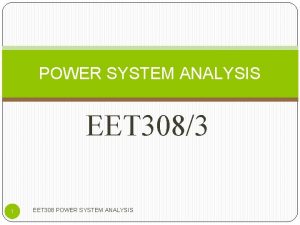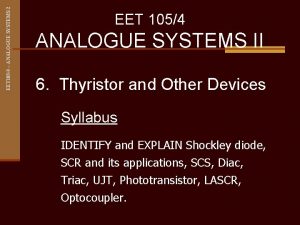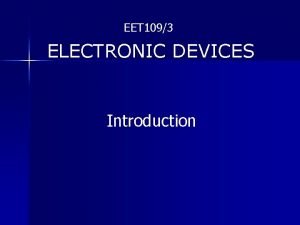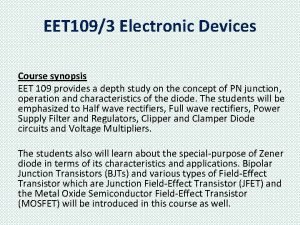EET 306 Electrical Machine Synchronous Machine School of




























































- Slides: 60

EET 306 Electrical Machine Synchronous Machine School of Electrical System Engineering DR. MOHAMAD NUR KHAIRUL HAFIZI BIN ROHANI Ph. D Blok 3, Cubicle 2 016 -7425020 1

Chapter 4: Synchronous Machine 4. 1 Sync. G : Constructional features & operation theory 4. 1. 1 Introduction 4. 1. 2 Salient pole rotor generators 4. 1. 3 Non-salient pole rotor generators 4. 1. 4 Different between Salient and Non-Salient pole generator 4. 1. 5 Principle Operation 4. 2 Sync. G : Basic parameter 4. 2. 1 Speed of rotation 4. 2. 2 Internal generated voltage 4. 2. 3 Equivalent circuit 4. 2. 4 Voltage regulation & Phasor diagram 4. 2. 5 Measuring model parameters 4. 3 Sync. G : Parallel operation of AC Generators 4. 4 Sync. M : Principle operation

Chapter 4: Synchronous Machine 4. 1 4. 2 4. 3 Sync. G : Constructional features & operation theory Sync. G : Basic parameter Sync. G : Parallel operation of AC Generators 4. 3. 1 Synchronization 4. 3. 2 Active and reactive power sharing between parallel generator. 4. 4 Sync. M : Principle operation 4. 4. 1 Basic Principle. 4. 4. 2 Method of starting. 4. 4. 3 V-curve Characteristic. .

4. 3 Sync. G : Parallel operation of AC Generators 4. 3. 1 SYNCHRONIZATION • Why in parallel? Advantages : i. iii. iv. Can supply a bigger load than one machine by it self. To increase the reliability of the power system, since the failure of any one of them does not cause a total power loss to the load. To allow one or more of them to be removed for shutdown and preventive maintenance. If only one generator is used and it is not operating near full-load, then it will be relatively inefficient. With several smaller machines in parallel, it is possible to operate only a fraction of them.

4. 3 Sync. G : Parallel operation of AC Generators` 4. 3. 1 SYNCHRONIZATION • The Conditions Required for Paralleling: The 2 rms voltagestoofbe 2 generators must be equal. of For sets line of voltages identical, rms magnitude voltages must The 2 generators must have the same phase sequence. Huge currents would flow in other two phases that not (a b c) sequence and damaging both machines. The angle of ‘phase a’ a’ forwill both equal. Thephase voltage in both ‘phase be machine identical must at all be times if magnitude andgenerator, angle are same The frequency of the new called oncoming generator, must be slightly higher than the frequency of The phase angles of oncoming running machine system. will changes slowly to be equal as running system, so the voltages can be observed.

4. 3 Sync. G : Parallel operation of AC Generators 4. 3. 1 SYNCHRONIZATION • The following steps describe the actual process of synchronizing two threephase alternator: i. ii. iii. Assume that alternator 1 is supplying energy to the bus bas of the station at rated voltage and frequency. An incoming machine, alternator 2, is to be synchronized with alternator 1 for the first time. The speed of alternator 2 is increased until it turns at the value required to give the desired frequency. The voltage of generator 2 is adjusted by means of its field rheostat until it is equal to that of generator 1. iv. The three voltages of the incoming generator must be in phase with the respective voltages of generator 1. To accomplish this, the phase sequence of the two alternators and their frequencies must be the same. The use of synchronizing lamps is a simple way to check these relationships.

Chapter 4: Synchronous Machine 4. 1 4. 2 4. 3 Sync. G : Constructional features & operation theory Sync. G : Basic parameter Sync. G : Parallel operation of AC Generators 4. 3. 1 Synchronization 4. 3. 2 Active and reactive power sharing between parallel generator. 4. 4 Sync. M : Principle operation 4. 4. 1 Basic Principle. 4. 4. 2 Method of starting. 4. 4. 3 V-curve Characteristic.

4. 3 Sync. G : Parallel operation of AC Generators 4. 3. 2 ACTIVE AND REACTIVE POWER SHARING BETWEEN PARALLEL GENERATOR. q. Introduction as Stand Alone: • When the generator is loaded • power is drawn from the mechanical system • the generator applies a torque which opposes the direction of motion of the mechanical system • As a result, the generator tends to slow down the mechanical system. • Changing mechanical speed is undesirable, as it results in a change in the frequency of the induced voltages. • For this reason, a "governor" is applied to the mechanical system to make the change in speed predictable with power changes.

4. 3 Sync. G : Parallel operation of AC Generators 4. 3. 2 ACTIVE AND REACTIVE POWER SHARING BETWEEN PARALLEL GENERATOR. q. Introduction as Stand Alone (Cont’d): • The governor or speed limiter sets the no-load speed and controls the reduction in speed so that the frequency-power relationship is linear: Figure : The plots show the linear reduction in speed as the power drawn from the mechanical system increases. • If the frequency of the generated voltages is too low, the frequency can be increased by increasing the no-load speed of the mechanical governor.

4. 3 Sync. G : Parallel operation of AC Generators 4. 3. 2 ACTIVE AND REACTIVE POWER SHARING BETWEEN PARALLEL GENERATOR. q. Introduction as Stand Alone (Cont’d): • Mathematically, the changes in frequency with load are described using two quantities, the Speed Droop, SD and the slope of the power-frequency plot, Sp. • Speed Droop, SD is defined as • Typical values for speed droop are in the range 2% - 4%

4. 3 Sync. G : Parallel operation of AC Generators 4. 3. 2 ACTIVE AND REACTIVE POWER SHARING BETWEEN PARALLEL GENERATOR. q. Introduction as Stand Alone (Cont’d): • The power from the generator can be found using: where; f. NL = no load frequency fsys = operating system frequency • The slope Sp is often quoted in k. W/Hz or MW/Hz.

4. 3 Sync. G : Parallel operation of AC Generators 4. 3. 2 ACTIVE AND REACTIVE POWER SHARING BETWEEN PARALLEL GENERATOR. q. Introduction as Stand Alone (Cont’d): • The effect of changes to terminal voltage with reactive load can be plotted on a diagram similar to the f-P plot; Figure : The plots show the linear reduction in voltage as the reactive-power drawn from the mechanical system increases. • Increasing the inductive load on the generator reduces the terminal voltage, adding capacitance increases the terminal voltage. Reductions to the terminal voltage can be compensated by increasing the no load voltage (|E|).

4. 3 Sync. G : Parallel operation of AC Generators 4. 3. 2 ACTIVE AND REACTIVE POWER SHARING BETWEEN PARALLEL GENERATOR. q. Introduction as Stand Alone (Cont’d): • In a stand-alone system, Power and Reactive Power drawn from a generator are determined by the load. • We will see with parallel operation that the demand on a generator in a parallel system can be controlled independently of the load requirements by adjusting the mechanical governor and excitation voltage.

4. 3 Sync. G : Parallel operation of AC Generators 4. 3. 2 ACTIVE AND REACTIVE POWER SHARING BETWEEN PARALLEL GENERATOR. q. Frequency-Real Power Characteristics: • Consider the case where 2 generators (G 1 & G 2) are connected to supply all the power requirements for a load. In this case the frequency-power plots: • The total power to the load, Pload is the sum of the power from each generator, PG 1 + PG 2.

4. 3 Sync. G : Parallel operation of AC Generators 4. 3. 2 ACTIVE AND REACTIVE POWER SHARING BETWEEN PARALLEL GENERATOR. q. Frequency-Real Power Characteristics (Cont’d): • Substituting to find the power from each generator in terms of the system frequency:

4. 3 Sync. G : Parallel operation of AC Generators 4. 3. 2 ACTIVE AND REACTIVE POWER SHARING BETWEEN PARALLEL GENERATOR. q. Frequency-Real Power Characteristics (Cont’d): • From the equation above it is clear that the system frequency is a function of both generator mechanical governors and no-load frequencies. • In addition, the power drawn from one generator is dependent on how the other generator is operated.

4. 3 Sync. G : Parallel operation of AC Generators 4. 3. 2 ACTIVE AND REACTIVE POWER SHARING BETWEEN PARALLEL GENERATOR. q. Frequency-Real Power Characteristics (Cont’d): ØChanging Load Power, Pload • With constant generator no-load speeds or frequencies, f. NL 1 & f. NL 2 ; • Changing load effects the system frequency, fsys.

4. 3 Sync. G : Parallel operation of AC Generators 4. 3. 2 ACTIVE AND REACTIVE POWER SHARING BETWEEN PARALLEL GENERATOR. q. Frequency-Real Power Characteristics (Cont’d): ØChanging Load Power, Pload • With constant generator no-load speeds or frequencies, f. NL 1 & f. NL 2 ; • Changing load effects the system frequency, fsys.

4. 3 Sync. G : Parallel operation of AC Generators 4. 3. 2 ACTIVE AND REACTIVE POWER SHARING BETWEEN PARALLEL GENERATOR. q. Frequency-Real Power Characteristics (Cont’d): ØChanging Load Power, Pload • With constant system frequency, fsys; • The generator set points can be adjusted. Both f. NL 1 & f. NL 2 must be adjusted in order to maintain the balance of power between Generators 1 & 2.

4. 3 Sync. G : Parallel operation of AC Generators 4. 3. 2 ACTIVE AND REACTIVE POWER SHARING BETWEEN PARALLEL GENERATOR. q. Frequency-Real Power Characteristics (Cont’d): ØChanging Load Power, Pload • With constant system frequency, fsys; • The generator set points can be adjusted. Both f. NL 1 & f. NL 2 must be adjusted in order to maintain the balance of power between Generators 1 & 2.

4. 3 Sync. G : Parallel operation of AC Generators 4. 3. 2 ACTIVE AND REACTIVE POWER SHARING BETWEEN PARALLEL GENERATOR. q. Frequency-Real Power Characteristics (Cont’d): ØConstant Load Power, Pload • The system frequency fsys can still be adjusted by controlling both generators or one of the generators alone, ; • Both f. NL 1 & f. NL 2 are adjusted to control the system frequency and to maintain the power balance between the generators.

4. 3 Sync. G : Parallel operation of AC Generators 4. 3. 2 ACTIVE AND REACTIVE POWER SHARING BETWEEN PARALLEL GENERATOR. q. Frequency-Real Power Characteristics (Cont’d): ØConstant Load Power, Pload • The system frequency fsys can still be adjusted by controlling both generators or one of the generators alone, • Both f. NL 1 & f. NL 2 are adjusted to control the system frequency and to maintain the power balance between the generators.

4. 3 Sync. G : Parallel operation of AC Generators 4. 3. 2 ACTIVE AND REACTIVE POWER SHARING BETWEEN PARALLEL GENERATOR. q. Frequency-Real Power Characteristics (Cont’d): ØConstant Load Power, Pload • The system frequency fsys can still be adjusted by controlling only one generator f. NL 2, with constant f. NL 1. • Changes both the power balance, PG 1 & PG 2 and fsys.

4. 3 Sync. G : Parallel operation of AC Generators 4. 3. 2 ACTIVE AND REACTIVE POWER SHARING BETWEEN PARALLEL GENERATOR. q. Frequency-Real Power Characteristics (Cont’d): ØConstant Load Power, Pload • The system frequency fsys can still be adjusted by controlling only one generator f. NL 2, with constant f. NL 1. • Changes both the power balance, PG 1 & PG 2 and fsys.

4. 2 Sync. G : Basic Parameter EXAMPLE 4. 3 A 480 -V, 250 -k. VA, 0. 8 -PF-lagging, two-pole, three-phase, 60 -Hz synchronous generator’s prime mover has a no-load speed of 3650 r/min and a full-load speed of 3570 r/min. It is operating in parallel with a 480 -V, 250 -k. VA, 0. 85 -PFlagging, four-pole 60 -Hz synchronous generator whose prime mover has a noload speed of 1800 r/min and a full-load speed of 1780 r/min. The loads supplied by the two generators consist of 300 k. W at 0. 8 PF lagging. (a) Calculate the speed droops of generator 1 and generator 2. [2. 24%, 1. 12%] (b) Find the operating frequency of the power system. . [59. 627 Hz] (c) Find the power being supplied by each of the generators in this system. . [181 k. W, 119 k. W] (d) What must the generator’s operators do to adjust the operating frequency to 60 Hz? (e) If the current line voltage is 460 V, what must the generator’s operators do to correct for the low terminal voltage? 25

Solution EXAMPLE 4. 3 26

Solution (cont’d) EXAMPLE 4. 3 (e) If the terminal voltage is 460 V, the operators of the generators must increase the field currents on both generators simultaneously. That action will increase the terminal voltages of the system without changing the reactive power sharing between the generators. 27

4. 3 Sync. G : Parallel operation of AC Generators 4. 3. 2 ACTIVE AND REACTIVE POWER SHARING BETWEEN PARALLEL GENERATOR. q. Voltage-Reactive Power Characteristics: • The house diagram and relationship for voltage variation with reactive power supply is constructed in a similar manner to the frequency-power characteristic.

Chapter 4: Synchronous Machine 4. 1 4. 2 4. 3 Sync. G : Constructional features & operation theory Sync. G : Basic parameter Sync. G : Parallel operation of AC Generators 4. 3. 1 Synchronization 4. 3. 2 Active and reactive power sharing between parallel generator. 4. 4 Sync. M : Principle operation 4. 4. 1 Basic Principle. 4. 4. 2 Method of starting. 4. 4. 3 V-curve Characteristic.

4. 4 Sync. M : Principle operation 4. 4. 1 BASIC PRINCIPLE. q. Introduction: • Synchronous motor construction, design and analysis is very similar to that used for synchronous generators. • Insight into principles of motor operation can be found by considering the qualitative equation for torque produced by two magnetic fields. • In a generator torque opposes motion, so the rotor flux density must lead the stator flux density. In a motor, the torque is in the same direction as motion, therefore the. rotor flux density, BR must lag the stator flux density, BS.

4. 4 Sync. M : Principle operation 4. 4. 1 BASIC PRINCIPLE. q. Introduction (Cont’d): • As in a synchronous generator, induced voltage EA is in phase with rotor flux density and terminal voltage V in phase with net field. • In a synchronous generator, E leads V. In a synchronous motor, EA lags VT.

4. 4 Sync. M : Principle operation 4. 4. 1 BASIC PRINCIPLE. q. Introduction (Cont’d): • Consider the armature circuit of a synchronous motor; By convention, armature current, IA is shown flowing into a motor. • Since the definition of positive current flow is different from that used for synchronous generators, the armature circuit equation is also different. Summing the voltages in the armature per phase circuit diagram:

4. 4 Sync. M : Principle operation 4. 4. 1 BASIC PRINCIPLE. q. Power and Torque: • If the armature resistance is significant, the output power and torque of a synchronous motor must be found by considering power flow in the machine: Pout Pconv LStray Lf&w Lcore Pin LI 2 R

Power Flow (Fish Bone) Sync Gen / Alternator Sync Motor RA = 0; PMAX when = 90;

General Sync Gen / Alternator & Sync Motor S θ Q P

4. 4 Sync. M : Principle operation 4. 4. 1 BASIC PRINCIPLE. q. Power and Torque: ; For 3 phase where; Rotational losses = Lstray + Lmech + Lcore

4. 4 Sync. M : Principle operation 4. 4. 1 BASIC PRINCIPLE. q. Introduction (Cont’d): • Using the above equation, the phasor diagrams for various power factors can be drawn as shown below;

4. 2 Sync. M : Basic Parameter EXAMPLE 4. 4 A 100 -hp 440 -V 0. 85 -PF-leading ∆-connected synchronous motor has an armature resistance of 0. 3 Ω and a synchronous reactance of 4. 0 Ω. Its efficiency at full load is 96 percent. (a) What is the input power to the motor at rated conditions? [77. 7 k. W] (b) What is the line current of the motor at rated conditions? What is the phase current of the motor at rated conditions? [120 A, 69. 3 A] (c) What is the internal generated voltage, EA of this motor at rated conditions? [634 <-21. 7⁰ V] (d) What are the stator copper losses in the motor at rated conditions? [4. 3 k. W] (e) What is Pconv at rated conditions? [73. 4 k. W] 38

Solution EXAMPLE 4. 4 39

Solution EXAMPLE 4. 4 40

4. 4 Sync. M : Principle operation 4. 4. 1 BASIC PRINCIPLE. q. Power and Torque: • As with synchronous generators, armature resistance can often be neglected without significant impact on analysis accuracy. • In this case the simplified armature circuit equation and phasor diagrams can be used.

Chapter 4: Synchronous Machine 4. 1 4. 2 4. 3 Sync. G : Constructional features & operation theory Sync. G : Basic parameter Sync. G : Parallel operation of AC Generators 4. 3. 1 Synchronization 4. 3. 2 Active and reactive power sharing between parallel generator. 4. 4 Sync. M : Principle operation 4. 4. 1 Basic Principle. 4. 4. 2 Method of starting. 4. 4. 3 V-curve Characteristic.

4. 4 Sync. M : Principle operation 4. 4. 2 METHODS OF STARTING. q. Introduction Assumption AC power applied to the stator (armature) causes a rotating magnetic field to be set up around the rotor (field). The DC excitation current (field current, If) in the rotor generates a flux acts like a bar magnet. The strong stator rotating magnetic field attracts and repels the strong rotor field. The attraction and repulsion will results in a strong turning force on the rotor shaft. The rotor is therefore able to turn a load as it rotates in step with the rotating magnetic field at armature. It should works this way once it’s started. BUT, in reality… synchronous motor cannot be started from a standstill by ONLY applying three-phase ac power to the stator… Why ? ?

4. 4 Sync. M : Principle operation 4. 4. 2 METHODS OF STARTING. q. Introduction (cont’d) • When ac is applied to the stator, a high-speed rotating magnetic field appears immediately. This rotating field rushes past the rotor poles so quickly that the rotor does not have a chance to get started. • Since the field is rotating at synchronous speed, the motor must be accelerated before it can pull into synchronism. • Therefore, separate starting means must be employed. • A synchronous motor in its purest form has no stating torque. • Synchronous motors produce torque only when it is running at synchronous speed, Øwhich brings up the question of how to start a synchronous motor? ? ? .

4. 4 Sync. M : Principle operation 4. 4. 2 METHODS OF STARTING. q. The three starting motor methods: • Reducing Electrical Frequency • Reduce the speed of the stator magnetic field to a low enough value that the rotor can accelerate and two magnetic fields lock in during one halfcycle of field rotation. This can be achieved by reducing the frequency of the applied electric power (which used to be difficult but can be done now). • External Prime Mover • Use an external prime mover to accelerate the synchronous motor up to synchronous speed, go through the paralleling procedure, and bring the machine on the line as a generator. Next, turning off the prime mover will make the synchronous machine as a motor.

4. 4 Sync. M : Principle operation 4. 4. 2 METHODS OF STARTING. q. The three starting motor methods (Cont’d): • Using Damper Windings or Amortisseur Windings – the most popular. • As addition to the field winding, a series of solid conductors passes through each pole. These solid conductors are short circuited at each end of the machine. This winding is called an Amortisseur or damper winding. • If the field winding is turned off, the Amortisseur winding will act like an induction machine cage winding and provide enough torque to accelerate the motor. Once the motor reaches synchronous speed the field winding is turned on and the motor synchronizes, providing synchronous torque. (The Amortisseur winding also acts to dampen speed variations due to sudden load changes. These windings are also found on synchronous generators to aid stability under transient load conditions)

4. 4 Sync. M : Principle operation 4. 4. 2 METHODS OF STARTING. q. The three starting motor methods (Cont’d): • Using Damper Windings or Amortisseur Windings – the most popular. Amortisseur Windings

4. 4 Sync. M : Principle operation 4. 4. 2 METHODS OF STARTING. (Summary) q. The three starting motor methods (Cont’d): 1. Reduce the stator frequency to a safe starting level. 2. Use an external prime move 3. Put amortisseur or damper windings on the motor to accelerate it to near synchronous speed before a direct current to the field winding.

Chapter 4: Synchronous Machine 4. 1 4. 2 4. 3 Sync. G : Constructional features & operation theory Sync. G : Basic parameter Sync. G : Parallel operation of AC Generators 4. 3. 1 Synchronization 4. 3. 2 Active and reactive power sharing between parallel generator. 4. 4 Sync. M : Principle operation 4. 4. 1 Basic Principle. 4. 4. 2 Method of starting. 4. 4. 4 Q-If curve Characteristic. 4. 4. 3 V-curve Characteristic.

4. 4 Sync. M : Principle operation 4. 4. 4 Reactive power – Field current Characteristic.

4. 4. 4 Reactive power – Field current Characteristic. 4. 4. 3 V-curve.

4. 4 Sync. M : Principle operation 4. 4. 3 V-curve.

4. 4 Sync. M : Principle operation 4. 4. 3 V-curve Characteristic. q. Introduction • One of the major and unique characteristics of this motor is that it can be operated at any electrical power factor leading, lagging or unity and this feature is based on the excitation of the synchronous motor. • Synchronous motor excitation refers to the DC supply given to field part which is used to produce the required magnetic flux.

4. 4 Sync. M : Principle operation 4. 4. 3 V-curve Characteristic. q. The V-curve

4. 4 Sync. M : Principle operation 4. 4. 3 V-curve Characteristic. q. The power factor • CASE 1: When the field current is sufficient enough to produce the air gap flux, as demanded by the constant supply voltage V, then the magnetizing current or lagging reactive VA required from ac source is zero and the motor operate at unity power factor. The field current, which causes this unity power factor is called normal excitation or normal field current. • CASE 2: If the field current is not sufficient enough to produce the required air gap flux as demanded by V, additional magnetizing current or lagging reactive VA is drawn from the AC source. This magnetizing current produces the deficient flux (constant flux- flux set up by dc supply rotor winding). Hence in this case the motor is said to operate under lagging power factor and the is said to be under excited. • CASE 3: If the field current is more than the normal field current, motor is said to be over excited. This excess field current produces excess flux ( flux set up by DC supply rotor winding – resultant air gap flux) must be neutralized by the armature winding. Hence the armature winding draws leading reactive VA or demagnetizing current leading voltage by almost 90 o from the AC source. Hence in this case the motor operate under leading power factor.

4. 4 Sync. M : Principle operation 4. 4. 3 V-curve Characteristic. q. As the power factor correction • An overexcited synchronous motor operate at leading power factor. • Under-excited synchronous motor operate at lagging power factor. • Normal excited synchronous motor operate at unity power factor. • This ability to selectively control power factor can be exploited for power factor correction of the power system to which the motor is connected. v. Since most power systems of any significant size have a net lagging power factor the presence of overexcited synchronous motors moves the system's net power factor closer to unity improving efficiency.

4. 4 Sync. M : Principle operation q. Main Features of Synchronous Motors • Synchronous motors are inherently not self starting. They require some external means to bring their speed close to synchronous speed to before they are synchronized. • The speed of operation is in synchronism with the supply frequency and hence for constant supply frequency they behave as constant speed motor irrespective of load condition. • This motor has the unique characteristics of operating under any electrical power factor. This makes it being used in electrical power factor improvement.

Synchronous Machines : Summary • Synchronous machines can operate as motors or generators. • In some cases, such as pumped storage hydro schemes, they are operated as both motors and generators. ØWhen motoring § EA lags Vᵩ § BR lags BS § Power flow is electrical to mechanical ØWhen generating § EA leads Vᵩ § BR leads BS § Power flow is mechanical to electrical.

Synchronous Machines : Summary • Sync motor runs only at sync speed at steady state and is related to the supply frequency. • If the mechanical load is increased/decreased in a sync motor its speed will momentarily decrease/increase resulting in the readjustment of the load or torque angle (with some oscillations) so as to be able to supply the new load (provided it is within its capacity) and finally speed will come back to its sync value.

Thanks You ~ANNA~ 60
 Eet machine
Eet machine Eet machine
Eet machine Cylindrical
Cylindrical Synchronous machine
Synchronous machine 888-306-0905
888-306-0905 Factors of 5 and 3
Factors of 5 and 3 Ecologist
Ecologist Operations management lecture notes doc
Operations management lecture notes doc Electromagnetic spectrum
Electromagnetic spectrum Ed 306
Ed 306 Virtudes teologales cuales son
Virtudes teologales cuales son Pc 306
Pc 306 Paulo sentelhas e angelocci geadas aula lce 306
Paulo sentelhas e angelocci geadas aula lce 306 Meteorologia
Meteorologia Meteorologia cesar
Meteorologia cesar 306
306 306 in expanded form
306 in expanded form Examples of dual devices
Examples of dual devices Product structure tree example
Product structure tree example Buad 306
Buad 306 306 bones
306 bones Navsup form 306
Navsup form 306 Som 306 csun
Som 306 csun Expanding expression tool visual
Expanding expression tool visual English exit test
English exit test Eet205
Eet205 Wat eet een koala
Wat eet een koala Eet writing test
Eet writing test Eet203
Eet203 Eet 203
Eet 203 Eet 203
Eet 203 Eet 2023
Eet 2023 Analog electronics
Analog electronics Wat eet een koe
Wat eet een koe Eet
Eet Eet 203
Eet 203 Ohalu
Ohalu Eets21308
Eets21308 Plattegrond emc
Plattegrond emc Eet 203
Eet 203 Hendershot
Hendershot Klipsch school of electrical and computer engineering
Klipsch school of electrical and computer engineering University of belgrade school of electrical engineering
University of belgrade school of electrical engineering Pony motor starting method
Pony motor starting method What is synchronous manufacturing
What is synchronous manufacturing Synchronous area framework agreement
Synchronous area framework agreement Pembelajaran synchronous dan asynchronous
Pembelajaran synchronous dan asynchronous Pembelajaran synchronous dan asynchronous
Pembelajaran synchronous dan asynchronous Synchronous reluctance motor working principle
Synchronous reluctance motor working principle Synchronous sequential circuits examples
Synchronous sequential circuits examples Sonet synchronous optical network
Sonet synchronous optical network Fdm
Fdm Synchronous speed formula
Synchronous speed formula Synchronous planting is an example of what control
Synchronous planting is an example of what control Synchronous vs asynchronous programming
Synchronous vs asynchronous programming Cmos leakage current
Cmos leakage current Multiplexing and spreading
Multiplexing and spreading 2-bit synchronous counter
2-bit synchronous counter Difference between asynchronous and synchronous
Difference between asynchronous and synchronous Synchronous culture
Synchronous culture Synchronous activities examples
Synchronous activities examples
